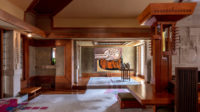Academic Worker–Led Strikes Across American Architecture Schools Reveal Inequities Nationwide

Picket signs were a ubiquitous sight during final studio reviews within UCLA's Architecture and Urban Design department late last year. Photo courtesy Kurt Pelzer
It should have come as no surprise when, early last November, more than 47,000 academic workers—a group that includes PhD students, lecturers, teaching assistants, and others—across the ten campuses of the University of California (UC) joined together to enact the largest academic strike in United States history. Living in the third most expensive state in the nation with an average salary of $24,000 and few benefits to speak of, the situation had simply become too untenable for too long while the services these workers provided to their respective departments had long gone undervalued. “We teach the classes, grade the papers, and perform the cutting-edge research that has earned UC its reputation as the best public university in the world,” explains the opening page of Fairucnow.org, one of many union-led websites created in recent months. “In short, UC works because we do.”
For those students and candidates within the PhD program at UCLA’s Architecture and Urban Design (AUD) department—most of whom rely almost exclusively on their salaries as academic workers, particularly international students, who are additionally burdened with several work restrictions—the discrepancy between wage and rent means that the precarity of a career in architecture scholarship is experienced well before they receive their diplomas. (To put this situation in perspective, the average monthly rent for a one-bedroom apartment in Westwood, the neighborhood surrounding UCLA, is $2,995, about 64 percent more than the average UC academic worker’s salary). “The strike truly felt like it was 50 years in the making,” said second-year AUD PhD student Adam Lubitz, drawing from his own knowledge as a historian to reflect on present conditions. “This has been building steadily since UC started charging tuition during Governor Reagan's first term in 1970.”
During the nearly six-week-long strike, the discussion sections within the AUD that were ordinarily led by PhD students/candidates, as well as the many undergraduate courses with which they assist, were suspended as the workers instead joined the larger UCLA student body to march across campus with picket signs and slogans. The chant “Hey Brett Steele, what’s the deal?,” for instance, was often heard outside the office of Brett Steele, dean of the UCLA School of the Arts and Architecture, who had not stated his position on the labor dispute throughout the negotiations. When reached for comment, Anne Marie Burke, executive director of Strategic Communications at UCLA Arts, relayed that while Steele was unavailable for an interview he did want to pass on “how much we respect and value our graduate student workers, how great it is to have them back for the winter quarter, and how pleased we are that the parties to this action were able to come together around a series of historic agreements yielding better compensation for graduate students.”

Photo courtesy Kurt Pelzer
Seeking solidarity with the students and faculty within the AUD’s Master of Architecture (M.Arch) department, a handful of academic workers and their supporters stood towards the back of final studio reviews. Their picket signs wallpapered the pin-up boards with the words “UNFAIR LABOR PRACTICE” while discussions on architectural formalism and materiality proceeded as they do every quarter. M.Arch students, who may be dismayed by the low salaries they will likely endure upon graduation, saw their peers struggling with those very issues in the present. Neil Denari, one of many AUD professors who conducted design studios throughout the strike, said in an email correspondence: "I was in support of the strike and the conditions that precipitated it …The issue here was just how one would define and act on a position of solidarity. Suspending the quarter was not any sort of feasible approach to solidarity, as it would have [had] a harmful effect on the students otherwise.”

Photo courtesy Kurt Pelzer
Following six weeks of student-led action and contract negotiations with the university, a new labor agreement was ratified by a majority of UC union members through a 2.5-year contract, increasing the minimum salary by about 68 percent and expanding benefits for international workers and those with children; this brought the strike to a close just before the end of the year. Still, the agreement remains incommensurate with California's high cost of living. “There are a lot of people that are getting screwed over with this contract,” Kurt Pelzer, a third-year AUD PhD student, said in conversation. “Why would anyone, particularly the many students within marginalized communities, want to continue putting energy toward an institution that clearly doesn't recognize the value of their labor?”
The expectations of unpaid or underpaid labor cannot be isolated to any one university. The UC-wide strike is only one of many that academic workers have taken against exploitative practices within architecture schools across the country. The Southern California Institute of Architecture (SCI-Arc), for instance, made headlines last year when students protested against the free labor commonly expected of them by its faculty (among a host of other allegations) that led to the resignation of then-undergraduate chair Tom Wiscombe and then-history and theory coordinator Marrikka Trotter. More recently, several members of the architecture faculty at both the University of Illinois at Chicago and Parsons School of Design in New York City joined university-wide strikes following several months of insufficient contract negotiations with their respective administrations. The decision to pursue a career in architecture—or any creative field, for that matter—can no longer be met with the expectation of mistreatment and exploitative labor, and must be asserted as worthy of dignity and fair pay; loudly and as often as necessary.



